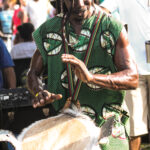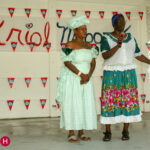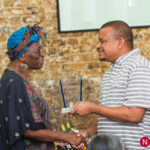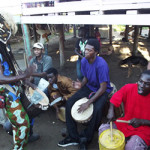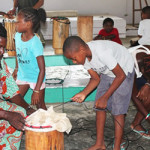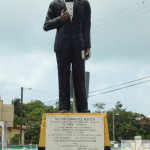Who are the Creole?
Who are the Creole?
Creole, in Belize, usually refers to people who are descendants from African and European ancestry. In other parts of the Americas, they are referred to as ‘Coloureds or Mulattoes’. Phenotypically, a Creole can range from very light skinned to dark. Creole is also used to describe ‘old world’ people born in the Americas.
It is a cliché in Belize to say that the Creole have no ‘kulcha’. Every society or group has a culture because it refers to the way the group behave, think and express themselves. As we shall see, the Creole culture is as strong and vibrant as any other ethnic group’s.
The Origin of the Creoles
The origin of the Creoles is intertwined with the modern history of Belize. The earliest record of the Europeans was around the mid-seventeenth century when the Treaty of Madrid, 1670 banned piracy and the price of logwood in European market encouraged former buccaneers to become logwood cutters. However, after mahogany came to dominate, there was an increased need for labour as mahogany extraction was more intensive than logwood. Thus the arrival of the Africans.
Despite what we may want to believe, slavery existed in Belize. It was a system where humans legally owned other humans and had full control over their lives. However, slavery was also a small part of African history and thus not define its descendants.
As there were few European women in the settlement, African women were taken as mistresses or common-law wives. These unions produced the Creole.
Belize Town until the mid-nineteenth century was basically an African Creole town- out of a population of six thousand, four thousand were black. The Creole communities in Belize District were established late in the nineteenth century and were mostly located at old mahogany camp sites and alongside rivers due to the lack of roads. Even today, the Belize River Valley, an area north of Belize City is still a Creole region. It includes the communities of SandHill, Crooked Tree, Double Head Cabbage, Isabella Bank, Burrell Boom Rockstone Pond, and Lemonal. In the west are St Matthews, Tea Kettle, Biscayne, Blackman Eddy while in the south are Gales Point Manatee, Monkey River and Punta Negro. Hattieville was founded shortly after Hurricane Hattie in 1961.
Who seh Kriol hav no Kulcha?
When the Africans arrived in the settlement, they did not forget their language, music, food and religion overnite. Nor was there was one African culture. We know that there were African tribes such as the “Congoes, Nangoes, Mongolas, Ashantees, Eboes and other African tribes” (Bolland, 2003: 90). These people proved resilient and coupled with the fact they were concentrated in Belize Town allowed them to create a culture out of African and European heritage. While we cannot specify which aspects are definitely African, European or even Belizean, there are certain parts we can say to be broadly so.
Food:
We are what we eat and it is no different for contemporary Belizeans. Those who immigrate to other countries find ingredients to cook their favourite ‘home’ dish- sere, rice n’ beans, stew chicken, tortillas and beans.
One of the origins of Creole cuisine was camp food. Food that kept well such as pig tail in brine, split peas, beans, and journey ‘johnny’ cake became a part of the diet and have remained favourites. Another favourite food is ‘Boil-up”- a concoction of boiled various ground food such as yam, ripe plantains, cassava, sweet potato. Pig tail and steamed fish are added to it and then the dish is garnished with tomato sauce and onion.
For those with a sweet tooth, there is potato pound, banana cake, wangla (candied sesame), cut-o-brute (minced candied coconut) and coconut pie to pick from.
Language
What is Creole language? Maybe it would be better to ask what it is not. Although most of the words are English-based, it includes African and other languages.
Creole is the national language spoken by Belizeans of all backgrounds. After a long period of controversy, it is generally acknowledged that Creole is a language and and is in the process of becoming standardized The Reporter Newspaper publishes a weekly ‘Wah Ah Gat fi Seh’ which is written in Creole.
Folklore
Proverbs and the folklore of Anansi have African roots. They were adapted to the new environment whilst keeping the meaning .e.g. “W’en fish come fram riba battam an tell you alligata hab bellyache, belief am”-When fish comes from the river bottom and tells you the alligator has a bellyache, believe it.
On Death and Wake
In 1791 a regulation was passed in Belize banning the practice of obeah. However, this belief did not die out as expected but is secretly carried on.
One activity that was not banned is the wake which has African and European elements. Its format seems to be unchanged over the centuries: the home is prepared for a feast and the copse is laid out. Games, alcohol and food available during the night. A burial follows. In the past, this was usually Anglican but with the introduction of Catholicism in the nineteenth century and other religious movement it can be any religion.
The ritual of Christmas
Where did the tradition of changing curtain, buying ‘marley’, varnishing furniture and eating cake, ham and turkey come from? And what about Brukdown- the music of festivity?
This period coincided with the lumber industry’s ‘off season’ in December and with the renewal of contracts and had little to do with Christmas. As a run up to the festivity everything made of wood was scrubbed; floors, walls, chairs and tables. According to Gladys Stuart, the Waikas, Mosquito Coast people who worked in camps, were notorious for their shopping sprees.
A major part of the celebration was the bram or dance. Stuart stated, “A session of bram in one house might last for a half hour to three or four hours depending on the amount of food and liquor served. When the food and drink were consumed, the whole group moved on to another house”.
Traditional Clothing
When does a certain of clothing become traditional or typical of a group? Stephens, an American diplomat visiting Belize in 1839 describes, ‘…the men in white cotton shirts and trousers, with straw hats, and the women in white frocks with short sleeves and broad red borders and adorned with large red earrings and necklaces…it was the fashion of these sable ladies to drop this considerably from off the right shoulder, and to carry the skirt in the left hand, and raise it to any height necessary for crossing puddles” (Stephens, 1899: 3). This costume has become ‘the traditional outfit’.
In a hundred years time, the clothes worn today may be considered traditional and be used for ceremonial and ritual purposes much in the same way as ‘ethnic’ costumes.
Politics
Because of its size and prominence, it was inevitable that Belize City would be the centre of political development. The Creole were part of the labour movement of 1894 as well as the 1919 riots. They also supported the General Workers Union and the subsequent political parties.
It was not until the early 70’s that a new movement, the United Black Association for Development was an alternative voice. One of their more important messages was a positive re-evaluation of Africanness. This may seem straight forward now but in the 70’s it was quite a revolutionary concept.
Sources/Further reading:
– O. Nigel Bolland. 2003, Colonialism and Resistance in Belize Essays in Historical Sociology, University of the West Indies Press and Cubola Books, Belize.
– John L Stephens, 1988 Travel, Incidents of Travel in Central American, Chiapas & Yucatan, Century Hutchinson, Great Britian.
– eds, Lita Krohn & Froyla Salam, 2004, Readings in Belizean History, Print Belize, Belize City.

